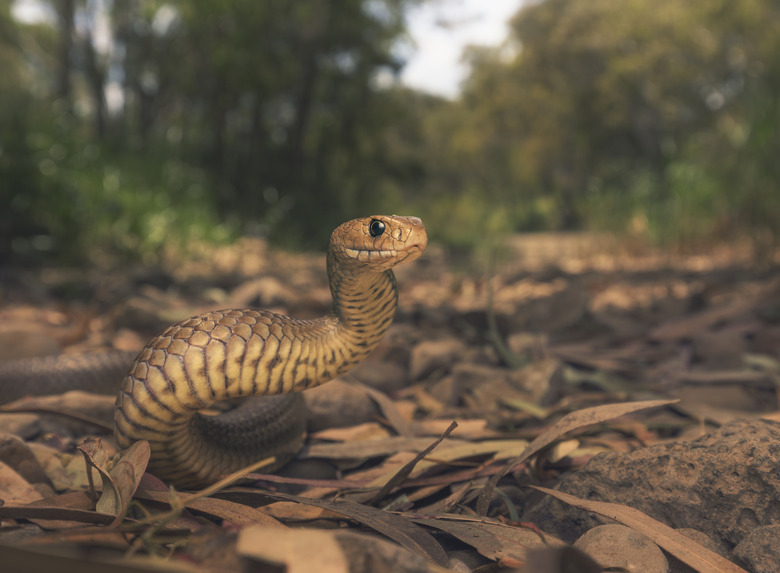Brown Snakes In Mississippi
Mississippi's southern climate makes it a great home for a number of snake species, some of which are brown in color. Some snakes are venomous, so being able to identify a snake species important, as it could save your life. Color is one way to identify snakes in Mississippi.
Smooth Earth Snake
Smooth Earth Snake
The smooth earth snake is a light tan- to brown-colored snake. The sandy brown coloration of the smooth earth snake helps it stay hidden in its sandy habitat through camouflage. The smooth earth snake is found all over Mississippi, except for the northeasternmost and northwesternmost points of the state. It is sometimes found in wooded areas but prefers open woodlands and the edges of forests.
Water Snakes
Water Snakes
Mississippi is home to four water snake species — the brown water snake, the Northern water snake, the plainbelly water snake and the Southern water snake. The plainbelly water snake has darker brown, triangular-shaped bands on top of a light brown base. The Southern water snake is one of the easiest to identify because it has sparse, white bands on top of a brownish-black base and two patches of light tan on the sides of its head. The Northern water snake has dark brown bands on top of a lighter brown base, and these bands are triangular in shape. The brown water snake is found throughout Mississippi, living in marshes, ponds, rivers, wetlands and any other body of fresh water. It has a base color of dark brown and might have black, brown, gray or reddish-orange bands running down the length of its body. Younger brown water snakes have a brighter brown coloration, while older snakes will be darker brown.
Brown Snake
Brown Snake
The brown snake is not to be confused with the common brown snake of Australia, which is one of the most deadly venomous snakes in the world. To further distinguish the two, the brown snake is sometimes called the Texas brown snake. The brown snake found in Mississippi is nonvenomous and is found all over the state. It is a light, dusty brown color with two darker brown stripes running down the length of its body, as well as a brown splotch on the side of its neck.
Coachwhip
Coachwhip
The coachwhip snake is found throughout Mississippi, but it is considered vulnerable. Vulnerable status means that the snake is nearing being endangered, but there are still significant numbers of the coachwhip in Mississippi. Other nearby states, such as Georgia and Louisiana, have higher coachwhip populations that are designated as secure in status, meaning they are thriving and abundant. The coachwhip has a dark brownish-green coloration. Unlike most snakes, it is diurnal, meaning it is active during the day.
Hognose Snakes
Hognose Snakes
The Eastern hognose snake and the Western hognose snake both live in Mississippi. These snakes are rear-fanged, which means they can inject a small amount of mild venom. Their venom is considered harmless, unless the person bitten has an allergic reaction in which case the treatment would be similar to the treatment of someone having a reaction to a bee sting. Both snakes have flat, upturned noses and are brown in coloration. The Eastern hognose is a brighter, yellowish-beige color with brown bands while the Western hognose is a duller beige color with brown spots running down its back and sides.
Venomous Brown Snakes
Venomous Brown Snakes
There are nine different venomous snakes in Mississippi, eight of which have brown coloration. Five of the eight snakes are rattlesnakes, including the canebrake rattlesnake, the Carolina pigmy rattlesnake, the Dusky pigmy rattlesnake, the Eastern diamond back and the Western pigmy rattlesnake. Each of these snakes has a variation of brown base color with gray or blackish bands, except for the Eastern diamond back, which is a dusty brown in color with black diamond shapes on its back. All of these rattlesnakes have an obvious rattle at the base of their tails. The Eastern cottonmouth and Western cottonmouth are dark, dull brownish-gray in color, and the copperhead snake is a brownish tan with very brightly colored copper bands running down its body. The Eastern cottonmouth and Western cottonmouth both look very similar to the brown water snake, but can be distinguished from the brown water snake by looking at their pupils. The cottonmouths, like all venomous snakes, have cat-like pupils while the nonvenomous brown water snake has round pupils.
Cite This Article
MLA
Papagiorgio, Nicole. "Brown Snakes In Mississippi" sciencing.com, https://www.sciencing.com/brown-snakes-mississippi-8583457/. 22 November 2019.
APA
Papagiorgio, Nicole. (2019, November 22). Brown Snakes In Mississippi. sciencing.com. Retrieved from https://www.sciencing.com/brown-snakes-mississippi-8583457/
Chicago
Papagiorgio, Nicole. Brown Snakes In Mississippi last modified March 24, 2022. https://www.sciencing.com/brown-snakes-mississippi-8583457/
